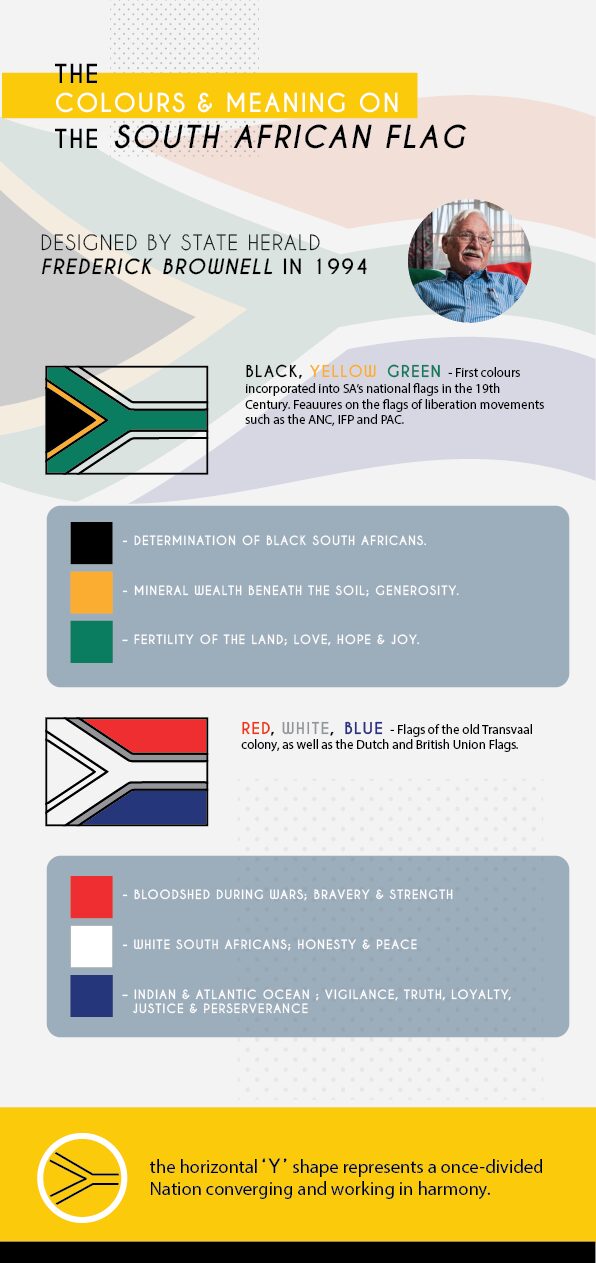The sense of pride and patriotism that comes with seeing the South African flying high anywhere is undeniable- whether it’s blowing graciously at a sporting event or firmly secured on a car as a sticker. After all, it’s a symbol of democracy, freedom and equality; a perfect summation of our country. But just how much do you know about the history and meaning of the South African flag?
Since it is #HeritageMonth in South Africa, we think it is the perfect time to look back at the story of how the South Africa flag came to be, what the composition and colours mean and what the law says about displaying the flag.
A brief history of the South African flag
In 1993, the Negotiating Council, which was in the process of setting up an interim Constitution for the newly democratic South Africa, set up a Commission on National Symbols. It’s primary task was to present four potential flags to represent South Africa from 1994 onwards. In just 5 weeks, the Commission had to present flags- with the help of public participation- that met the following criteria:
- It must be a unique design
- it should promote and symbolise national unity
- the design must be simple to the point where a child can recognise and draw it
- primary colours are preferred
- designs to be submitted in full colour
- a brief motivation and explanation of the design may also be included.
After approximately 7000 entries were whittled down to just 6, the Commission presented their findings; however, neither the South African public or the Council were impressed, and the search continued. This time, agencies and design studios were called on to submit proposals, but none were successful. Eventually, a sub-committee was instated, which ultimately created a Technical Working Committee. The convener on that committee was the late Mr. Fred Brownell, who designed the flag we know and love now just a month before South Africa’s democratic elections, and it was first used on 27 April 1994.
The colours and meaning on the South African flag
Black, gold (or yellow) and green feature quite prominently as those colours represent political parties, like the ANC and PAC, who were instrumental in the liberation movement in South Africa. On a somewhat more figurative level, the green almost stands for fertility and the yellow for mineral wealth.
The bright red at the top of the flag simultaneously symbolises the bloodshed of the past and the strength required for moving forward, and the vibrant blue at the bottom of the flag represents the ocean and the sky, as well as truth, loyalty and perseverance.
In terms of composition, the horizontal ‘Y’ shape represents a once-divided Nation converging and working in harmony.
What South Africans aren’t allowed to do with the flag
While there are very specific protocols for the official use of the flag, as per the The Southern African Vexillological Association (SAVA), everyday citizens also have to abide by certain rules when it comes to displaying the South African flag.
5 things you shouldn’t do with the South African flag
- Your proudly South African Speedo or undies? Well, they are technically forbidden by SAVA. You are not allowed to wear the flag on trousers or underwear.
- If you are thinking of hosting a Heritage Day braai, by all means fly the flag with pride, but do not use it as a tablecloth. The flag cannot be eaten over or used as a floor mat ( in case you are thinking of bringing a little patriotism into your bathroom décor). It’s considered demeaning.
- Don’t flip it or reverse it! Usually, a nation’s flag that is upside down means the country has surrendered to an enemy. So, remember, keep the red part at the top!
- The rules call for the flag to be taken down before sunset (for state and personal use), unless it is very well lit and displaying clearly.
- Any monument or historically significant statue or plaque may not be wrapped in or covered by the South African flag.
Take a moment to appreciate the South African flag
Of course, with all that’s happening in our country, it is easy to be disheartened and feel deflated. But it’s also important to keep the hope for a better South Africa alive and kicking. So, next time you see the South African flag blowing elegantly in the wind, take a moment to absorb all that it stands for, especially during Heritage Month.
We’ve got your back!
Need a caring friend in the law on your side?
Be sure to have a look at LAW FOR ALL’s comprehensive policies and sign up today!
—
—
